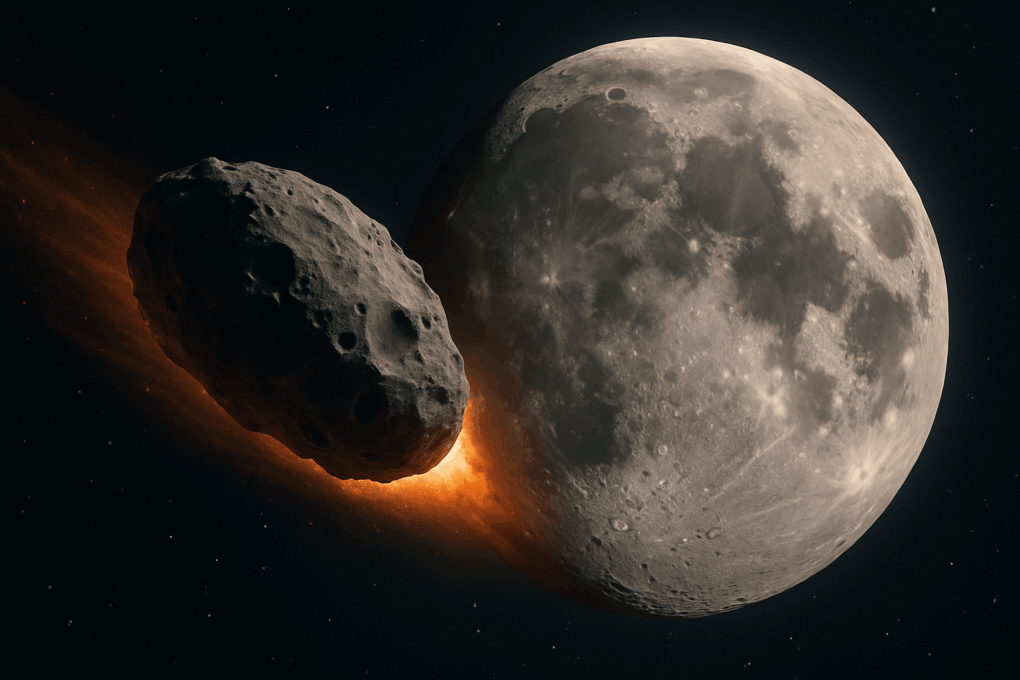
In a world still reeling from climate disasters, geopolitical tensions, and pandemic aftershocks, space has thrown us another curveball.
Scientists have confirmed that asteroid 2024 YR4, a massive space rock over 200 feet in diameter, is hurtling through the solar system on a path that may graze the Moon later this year. Though Earth itself is not in the direct line of fire, experts warn that a lunar collision could have serious ripple effects—both physical and psychological.
While the asteroid won’t make impact with our planet, the possibility of it striking the Moon has become a growing concern for astronomers, space agencies, and even global policymakers.
What is Asteroid 2024 YR4?
Discovered in December 2024 by NASA’s Pan-STARRS observatory in Hawaii, Asteroid 2024 YR4 was initially classified as a Potentially Hazardous Object (PHO). Traveling at nearly 19,000 miles per hour, the asteroid’s trajectory was projected to miss Earth by just over 30,000 miles—closer than many communication satellites orbiting our planet.But in the months since its discovery, updated models have raised concerns that the Moon could be within its strike zone. Though the Moon is an uninhabited, lifeless body, the consequences of a high-velocity impact are anything but trivial.
A Lunar Collision: Why It Matters—
Let’s be clear: the asteroid won’t turn the Moon into rubble. But an object of this size slamming into the lunar surface would unleash the equivalent energy of multiple nuclear bombs. It could carve out a fresh crater the size of a small city and hurl tons of debris into orbit.
Here’s where it gets complicated. That lunar debris could pose a serious threat to:Earth-orbiting satellites – GPS, weather, communication, and military systems could be damaged or destroyed.
The International Space Station (ISS) – Depending on orbital overlap, stray debris could endanger astronauts. Future lunar missions – NASA’s Artemis program and other moonbase plans may face serious setbacks. Space debris is already a critical issue. A lunar impact could magnify that problem tenfold—especially if debris is pulled into Earth’s gravity well.
A New Kind of Risk Assessment—
Until now, most space monitoring systems have focused on protecting Earth. But the threat to the Moon—our natural satellite—has revealed a major blind spot in planetary defense protocols.
Dr. Melissa Grant of the Jet Propulsion Laboratory explains:
“We’ve always asked, ‘Will it hit Earth?’ Maybe we should also ask, ‘What happens if it hits something else?’ A lunar impact can still affect life down here.”In response, NASA and ESA (European Space Agency) are now pushing for a “Lunar Impact Scale”—a new classification to evaluate non-terrestrial risks posed by Near-Earth Objects (NEOs).
The Psychological Shockwave:
Beyond the physical threats, experts are raising another red flag: the cultural and emotional impact of a lunar collision.For millennia, the Moon has been a symbol of stability, myth, and romance. From ancient calendars to religious rituals, it has been humanity’s quiet companion. If it suddenly sported a fresh scar—visible through telescopes and cameras around the world—people may react in unexpected ways.
Astronomer and science communicator Dr. Kai Alvarez puts it this way: “A scarred Moon is a visual reminder of how vulnerable we really are. We may not be directly hit, but we’ll all feel it.”
This kind of event could spark a renewed interest in space, but it might also cause fear, conspiracy theories, or panic in more impressionable populations.
Next Steps: Eyes on the Sky
The next few months are crucial. NASA’s DART program—which successfully redirected a small asteroid in 2022—is being reevaluated for possible emergency deployment options. Though 2024 YR4 is too large to deflect with current technology, monitoring and contingency planning are ramping up.
The most likely scenario is that the asteroid will miss both the Earth and the Moon—a cosmic near-miss that will fade from the news cycle.
But in a world used to dismissing “what-ifs,” this incident reminds us of one universal truth: Space doesn’t care what we’re prepared for. It just is.
If asteroid 2024 YR4 strikes the Moon, we’ll witness a once-in-a-lifetime celestial event. If it doesn’t, we get a chance to learn—without paying the price. Either way, this close encounter reminds us that space is not an empty void. It’s a living, moving theater of uncertainty.And like every good show, it deserves our attention—before the next act begins.

Your comment will appear immediately after submission.